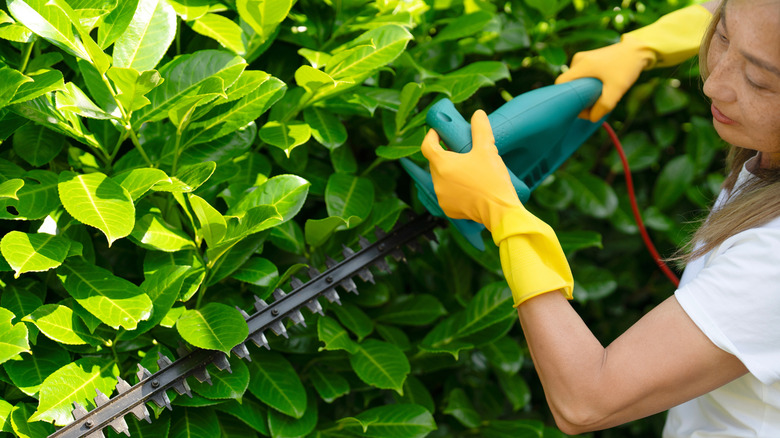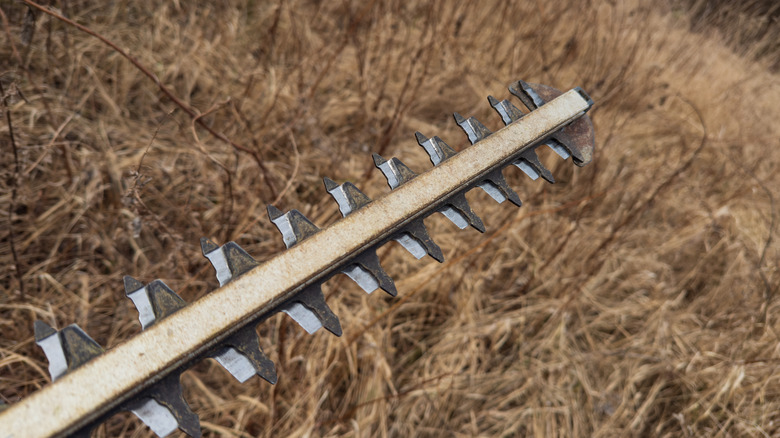How To Properly Sharpen The Blades On Your Hedge Trimmers
We may receive a commission on purchases made from links.
Unless you're Edward Scissorhands, keeping hedges looking their best takes a whole lot of time and effort and the right tools. An electric or gas-powered hedge trimmer can help keep your hedges in tip-top shape, but only if it's sharpened and ready to go. Like many landscaping and groundskeeping tools, hedge trimmers can become dull over time, and this will make them less effective. Dull blades can be frustrating to use as they tear branches more easily and don't cut them cleanly. They may even increase the risk of accidents.
A lot of videos out there recommend rotary tools or even circular saws and grinders as quick hacks to sharpen your hedge trimmer, but the best and safest way to sharpen your tool is with good old-fashioned elbow grease and a flat file, or mill file. While grinding tools can sharpen blades faster, they can easily over-sharpen your trimmer. This can actually weaken the metal, so avoid grinders or rotary tools unless you're an expert at using them.
If you're unsure, you can always drop off your hedge trimmer at a tool shop or gardening center to be professionally sharpened. But if you want to do it yourself, use a file to sharpen your trimmer. Always check your tool's manual first, of course, for any special instructions for sharpening the blades. For most hedge trimmers, you'll be filing along the edge of every tooth in a downward motion. This will ensure you sharpen every tooth of the tool evenly.
Sharpen your hedge trimmers when they start to do this
But how do you know when you need to sharpen your tool? There are lots of warning signs. Dull trimmers tend to slip off branches. They might also get caught on branches, or get jammed up with leaves or limbs more often. Another sign the blades have become dull is if you find yourself having to go over the same spots over and over again, and just are generally exerting more effort for the same results.
Sometimes, dull cutters will led to poorly cut shrubs with torn leaves that will brown. Of course, too much fertilizer in the soil can turn green leaves brown, so learn how to fertilize hedges properly to keep them healthy. It's not a bad idea to learn the difference between shrubs and hedges, either, as hedges often require more pruning and care than shrubs.
So how do you sharpen a dull trimmer? First, you'll need a mill file, a whetstone, gloves, googles, a clean rag, machinery oil or resin, and a large flat service area, like a workbench or tabletop. Before you even start sharpening, always make sure your hedge trimmer is unplugged or that the battery is removed. The last thing you want is for the tool to power up while you're working on it. Also, wear goggles to protect your eyes from flying bits of sharp, metal flint. Pull on some gloves, too, because even dull teeth can be sharper than you think.
Follow these easy steps to sharpen your hedge trimmer
To sharpen your trimmer just follow a few easy steps. Lay your hedge trimmer on a flat, even surface, like a workbench or a tabletop. Secure it if you'd like. Then, start by cleaning the blades with a dry cloth or add some WD-40 to help rid the tool of dirt or lingering tree sap.
Grab the mill file and move in a single downward motion on the first tooth, following the blade. Remember, never file backward. Always lift up when moving back or you risk undoing some of your work by blunting the edge. Use the same number of strokes for each tooth. Typically, this will be a few swipes, or until you see a shiny bit of metal. Don't over-sharpen as this could actually damage the tool by weakening the metal and making it more prone to breakage. You want to sharpen evenly so your tool cuts evenly.
Keep repeating these steps until you've sharpened all the teeth of your power tool. Filing will make rough edges, or burrs, so flip over the power tool and run a whetstone along each blade to smooth out the surface. Clean off the sharpened blades with a rag or brush, and make sure you've removed all the metal flint bits. Once done with that, just spray or swipe on a coat of protective machine oil on the blades, like Planet Safe Aim hedge trimmer lubricant, and then you're good to go.

